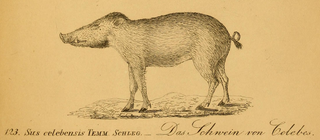
The Celebes warty pig, also called Sulawesi warty pig or Sulawesi pig, is a species in the pig genus (Sus) that lives on Sulawesi in Indonesia. It survives in most habitats and can live in altitudes of up to 2,500 metres (8,200 ft). It has been domesticated and introduced to Papua New Guinea.
The Sulawesi yellow bat is a species of vesper bat. It is found only in Indonesia.
The Celebes shrew-rat is a species of rodent in the family Muridae. It is found only in Sulawesi, Indonesia. Its natural habitat is subtropical or tropical dry forests. It is threatened by habitat loss.

The Celebes rat is a species of rodent in the family Muridae. It is found only in Sulawesi, Indonesia.

The dark-eared myza, also known as the lesser streaked honeyeater, is a species of bird in the family Meliphagidae. It is endemic to the island of Sulawesi in Indonesia. There are two subspecies, Myza celebensis celebensis which is found in mountainous parts of northern, central and southeastern Sulawesi, and Myza celebensis meridionalis from mountains in southern Sulawesi.

The Sulawesi dwarf cuscus is a species of arboreal marsupial in the family Phalangeridae endemic to Sulawesi and nearby islands in Indonesia. It inhabits tropical moist lowland forest and is nocturnal, folivorous and usually found in pairs. S. celebensis is threatened by hunting and deforestation.
Harpyionycteris is a genus of megabat in the family Pteropodidae. It contains the following species:

The Sulawesi horseshoe bat is a species of bat in the family Rhinolophidae. It is endemic to Indonesia.

The Sulawesi rousette is a species of megabat in the family Pteropodidae endemic to Sulawesi, an island in Indonesia.
The Timor warty pig is a subspecies of Sus celebensis, or Celebes warty pig. Though described as a separate species, it is a feral form of the Celebes warty pig found in the Lesser Sunda Islands.

The Sulawesi harpy fruit bat is a species of megabat in the family Pteropodidae. It is endemic to Indonesia.
"This species occurs in Sulawesi, Indonesia. It is also found in Soloi on Buton island in Indonesia. It occurs from sea level up to 2,120m asl or probably higher. This species is not common. In 2002, three individuals were captured at a single locality. Population Trend ↓ Decreasing. It seems to require good forest, but has also been recorded from cocoa plantations. Soloi individuals were caught over a river in undisturbed forest. Roosting habits are not known, but this species is not likely to be a cave dweller. Hunting for sale at market, and forest loss due to expanding agriculture and logging represent major threats to this species. This species is known to occur in Domoga-bone National Park."

Homonoeini is a tribe of longhorn beetles of the Lamiinae subfamily. It was described by Thomson in 1864.
Notomulciber is a genus of longhorn beetles of the subfamily Lamiinae, containing the following species:
Notomulciber javanicus is a species of beetle in the family Cerambycidae. It was described by Stephan von Breuning in 1956.
Notomulciber travancorensis is a species of beetle in the family Cerambycidae. It was described by Stephan von Breuning in 1958.
Notomulciber sexlineatus is a species of beetle in the family Cerambycidae. It was described by Stephan von Breuning in 1959.
Notomulciber palawanicus is a species of beetle in the family Cerambycidae. It was described by Stephan von Breuning and de Jong in 1941. It is known from the Philippines.
Notomulciber biguttatus is a species of beetle in the family Cerambycidae. It was described by Francis Polkinghorne Pascoe in 1867. It is known from Borneo and Malaysia.
Notomulciber quadrisignatus is a species of beetle in the family Cerambycidae. It was described by Bernhard Schwarzer in 1925, originally under the genus Micromulciber. It is known from Taiwan.
Notomulciber carpentariae is a species of beetle in the family Cerambycidae. It was described by Blackburn in 1894. It is known from Australia.









